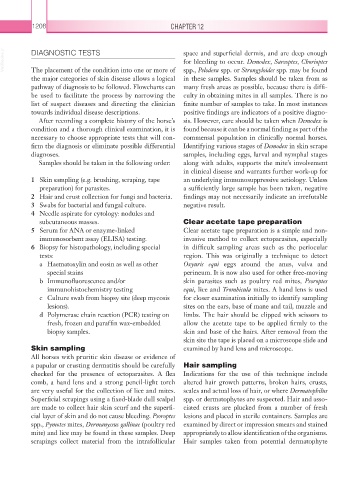Page 1233 - Equine Clinical Medicine, Surgery and Reproduction, 2nd Edition
P. 1233
1208 CHAPTER 12
VetBooks.ir DIAGNOSTIC TESTS space and superficial dermis, and are deep enough
for bleeding to occur. Demodex, Sarcoptes, Chorioptes
The placement of the condition into one or more of
in these samples. Samples should be taken from as
the major categories of skin disease allows a logical spp., Pelodera spp. or Strongyloides spp. may be found
pathway of diagnosis to be followed. Flowcharts can many fresh areas as possible, because there is diffi-
be used to facilitate the process by narrowing the culty in obtaining mites in all samples. There is no
list of suspect diseases and directing the clinician finite number of samples to take. In most instances
towards individual disease descriptions. positive findings are indicators of a positive diagno-
After recording a complete history of the horse’s sis. However, care should be taken when Demodex is
condition and a thorough clinical examination, it is found because it can be a normal finding as part of the
necessary to choose appropriate tests that will con- commensal population in clinically normal horses.
firm the diagnosis or eliminate possible differential Identifying various stages of Demodex in skin scrape
diagnoses. samples, including eggs, larval and nymphal stages
Samples should be taken in the following order: along with adults, supports the mite’s involvement
in clinical disease and warrants further work-up for
1 Skin sampling (e.g. brushing, scraping, tape an underlying immunosuppressive aetiology. Unless
preparation) for parasites. a sufficiently large sample has been taken, negative
2 Hair and crust collection for fungi and bacteria. findings may not necessarily indicate an irrefutable
3 Swabs for bacterial and fungal culture. negative result.
4 Needle aspirate for cytology: nodules and
subcutaneous masses. Clear acetate tape preparation
5 Serum for ANA or enzyme-linked Clear acetate tape preparation is a simple and non-
immunosorbent assay (ELISA) testing. invasive method to collect ectoparasites, especially
6 Biopsy for histopathology, including special in difficult sampling areas such as the periocular
tests: region. This was originally a technique to detect
a Haematoxylin and eosin as well as other Oxyuris equi eggs around the anus, vulva and
special stains perineum. It is now also used for other free-moving
b Immunofluorescence and/or skin parasites such as poultry red mites, Psoroptes
immunohistochemistry testing equi, lice and Trombicula mites. A hand lens is used
c Culture swab from biopsy site (deep mycosis for closer examination initially to identify sampling
lesions). sites on the ears, base of mane and tail, muzzle and
d Polymerase chain reaction (PCR) testing on limbs. The hair should be clipped with scissors to
fresh, frozen and paraffin wax-embedded allow the acetate tape to be applied firmly to the
biopsy samples. skin and base of the hairs. After removal from the
skin site the tape is placed on a microscope slide and
Skin sampling examined by hand lens and microscope.
All horses with pruritic skin disease or evidence of
a papular or crusting dermatitis should be carefully Hair sampling
checked for the presence of ectoparasites. A flea Indications for the use of this technique include
comb, a hand lens and a strong pencil-light torch altered hair growth patterns, broken hairs, crusts,
are very useful for the collection of lice and mites. scales and actual loss of hair, or where Dermatophilus
Superficial scrapings using a fixed-blade dull scalpel spp. or dermatophytes are suspected. Hair and asso-
are made to collect hair skin scurf and the superfi- ciated crusts are plucked from a number of fresh
cial layer of skin and do not cause bleeding. Psoroptes lesions and placed in sterile containers. Samples are
spp., Pymotes mites, Dermanyssus gallinae (poultry red examined by direct or impression smears and stained
mite) and lice may be found in these samples. Deep appropriately to allow identification of the organisms.
scrapings collect material from the intrafollicular Hair samples taken from potential dermatophyte

